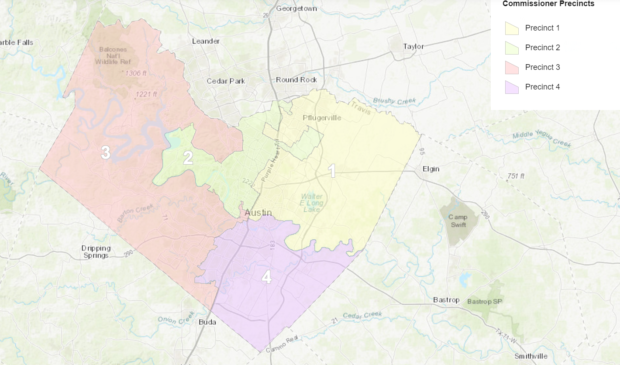Travis County considers nonpartisan redistricting
Tuesday, August 27, 2019 by
Jack Craver In contrast to most elected officials around the country, members of the Travis County Commissioners Court say they don’t want to be in charge of picking their voters. At their Aug. 20 meeting, the commissioners discussed setting up a nonpartisan redistricting commission similar to the city’s. The commission would be tasked with redrawing the four commissioners’ precincts as well as the county’s roughly 200 voting precincts in 2021.
Under the city’s model, redistricting is conducted by a panel of 14 people randomly selected from a pool of applicants (any registered voter who has voted in three of the last five general elections may apply).
“If we wanted to, we could be an exemplar, and we could establish, as the city of Austin has, an independent redistricting committee,” said Eckhardt, drawing approval from Commissioner Brigid Shea.
Commissioner Jeff Travillion expressed support for the concept but stressed the importance of having a redistricting commission that includes “the perspectives of folks who are not politically powerful.”
Commissioner Margaret Gómez said the city’s redistricting commission had set a good example by prioritizing the creation of districts aimed at empowering black and Latino populations.
While the state requires counties to redraw commissioner precincts and voting precincts every decade to account for population changes, it gives county governments broad discretion in how they go about drawing the new boundaries.
In the past, the commissioners have been in charge of the process, working with consultants to draw precincts based on their preferences. While that process is officially nonpartisan, it’s also inevitably political. Elected officials are unlikely to push for boundary changes that jeopardize their power or the power of their party.
“By its very nature it’s highly political and it creates a lot of tension on our dais,” said Eckhardt.
In a 5-4 decision in June, the U.S. Supreme Court ruled that courts cannot interfere in the redistricting process to reverse partisan gerrymandering. Even clear evidence that maps are drawn to benefit one political party does not render the districts unconstitutional, the court ruled.
A set of redistricting principles adopted by the court in 2011 commits the court to drawing precincts that are “reasonably compact and contiguous” and that do not dilute the voting power of any racial or ethnic minority. The documents also says that, “to the extent permissible by the law, the Court may take into account the interests of incumbents and political voting patterns.”
Whoever is in charge of the redistricting process will have to contend with a major increase in population that has not been evenly distributed throughout the county.
Precinct 3, which covers most of the southwestern portion of the city as well as a large expanse of western Travis County, grew by 24.3 percent, or 64,791 people, between 2010 and 2017, according to an American Community Survey five-year estimate.
That precinct, which is represented by Commissioner Gerald Daugherty, the court’s lone Republican, is still the county’s whitest, but the Anglo share of the population dropped from 75 percent to 69 percent due to upticks in Latino and Asian populations.
The second-fastest growth was in Commissioner Jeff Travillion’s Precinct 1, which roughly covers the northeastern quadrant of the county. It grew by 19 percent, or 49,323 people. Although the precinct is still home to by far the largest black population, African Americans now only account for 16 percent of the total, down from 20 percent, while Anglo, Latino and Asian populations have slightly gained in share.
Meanwhile, the majority-white Precinct 2, which encompasses much of West and Central Austin and is represented by Commissioner Brigid Shea, only grew by 5.7 percent (14,931 people). And the majority-Latino Precinct 4, represented by Commissioner Margaret Gómez, grew by 9.5 percent (23,291).
As a result, Shea and Gómez’s precincts will have to expand to add population, while Travillion and Daugherty’s precincts will have to become smaller.
Travis County precinct map courtesy of Travis County.
The Austin Monitor’s work is made possible by donations from the community. Though our reporting covers donors from time to time, we are careful to keep business and editorial efforts separate while maintaining transparency. A complete list of donors is available here, and our code of ethics is explained here.
You're a community leader
And we’re honored you look to us for serious, in-depth news. You know a strong community needs local and dedicated watchdog reporting. We’re here for you and that won’t change. Now will you take the powerful next step and support our nonprofit news organization?









